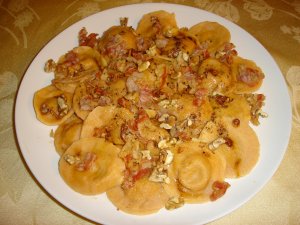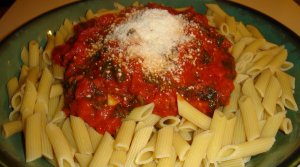
My darling daughter wanted to bake pumpkin pies for Thanksgiving so we had a large can of pumpkin puree leftover. For the past few months, I’ve been seeing pumpkin ravioli in various forms just about everywhere I go so I decided to experiment with creating my own pumpkin ravioli recipe. The results were homey but sophisticated. This beautiful dish looks difficult to prepare but it’s not even though there are multiple steps. You can impress your dinner guests without breaking a sweat if you follow the recipe one step at a time. The trick is to allow yourself plenty of time to put it all together, maybe even preparing the ravioli beforehand and freezing them. I made a large batch of ravioli and froze some of it in single layers separated by wax paper. They cooked up like a dream and retained the freshness that comes from making your own pasta by hand.
PUMPKIN RAVIOLI WITH PANCETTA & WALNUTS
For the ravioli filling:
1 1/2 cups pumpkin puree (this is not the same as pumpkin pie filling, which is already seasoned)
1/2 cup grated parmesan cheese
1/2 teaspoon salt
1/2 teaspoon white pepper
1/2 teaspoon nutmeg
For the fresh pasta:
3/4 cup unbleached flour
3/4 cup semolina flour, plus 1/4 cup semolina for dusting the work surface
1/2 teaspoon salt
2 eggs
2 tablespoons water
2 tablespoons olive oil
2 teaspoons tomato paste
For the sauce:
5 tablespoons unsalted butter
1 large shallot, minced
4 ounces of pancetta, shredded
1 teaspoon dried sage
1/4 cup toasted and chopped walnuts
To prepare the filling: In a medium sized bowl, thoroughly mix together all of the ingredients for the ravioli filling. Refrigerate until you’re ready to fill the ravioli.
To prepare the pasta:
1. On a cutting board or other flat surface, make a mound with the flour and 3/4 of a cup of the semolina. Create a small well in the center.
2. In small bowl, beat together the eggs, salt, water, olive oil and tomato paste.
3. Pour the eggs into the center of the well.
4. Use a large fork to slowly incorporate the dry ingredients into the eggs, pushing a little from the inside wall of well into the eggs and stirring slowly in a circular motion until all of the ingredients are mixed together.
5. You should have a soft, somewhat crumbly dough. If it’s too crumbly to hold together with pressure, knead in an extra egg white.
6. Dust the work surface with some of the reserved semolina. Knead the pasta dough for ten minutes, until pliable and smooth.
7. Fashion the dough into a ball and wrap in plastic wrap. Let rest in the refrigerator for 30 minutes.
8. Divide the dough into six equal pieces. If you’re lucky enough to have a pasta machine, follow the manufacturer’s instructions for rolling the dough to create sheets for ravioli. If you’re like me and have no machine, you are about to have a really fun time rolling that dough by hand.
9. To roll by hand, dust the work surface with semolina and rub a little on a rolling pin. Use your hands to pat a portion of the dough into a flat oval or rectangle. Using the rolling pin, roll with firm pressure to create a thin, almost translucent sheet of pasta, about 12 inches by 14 inches.
10. Use a wine glass or round cookie cutter to cut out circles in the dough. Gently remove the excess dough and save to roll out again.
11. To make the individual ravioli pieces, place one rounded teaspoon of filling in the middle of one circle. Using your finger or a small pastry brush, brush water on the exposed dough around the filling. Use another circle to make the top, gently stretching the dough to cover the filling and firmly sealing the edges with your fingers. You can be fancy and crimp the edges with a fork or use a fluter to trim the edges. Or leave them plain. Whatever you want.
12. Place finished ravioli on a piece of wax paper or a clean, moist dishtowel until ready to cook.
13. Repeat steps 9 through 12 until all of the filling and dough is gone.
14. If freezing for later use, line a container with wax paper and place ravioli in single layers, each separated by a layer of wax paper. This will stay fresh in the freezer for a couple of months.
15. To cook fresh or frozen ravioli, bring a large pot of water to a boil. Drop in the ravioli one by one. Lower heat and allow water to simmer. Stir ravioli gently to prevent them from sticking together. Fresh ravioli cooks in five to six minutes. Frozen ravioli cooks in about 12 minutes.
16. Remove cooked ravioli with a slotted spoon to a deep platter.
To prepare the sauce:
1. While the ravioli is cooking, melt the butter in a small skillet over high heat.
2. When the butter is melted and beginning to brown, add the shallots. Cook until the shallots begin to turn golden.
3. Add the pancetta and saute until the pancetta become crisp.
4. Add the sage and cook for another minute or two to incorporate the flavors.
5. Pour the sauce over the ravioli.
6. Sprinkle walnuts over the ravioli and serve immediately.
Should make 40 ravioli, if you roll out the dough thin enough. Serves 4.
PS: Vegetarians can leave out the pancetta to create a meat free dish. Try adding an extra shallot or a little garlic instead.


